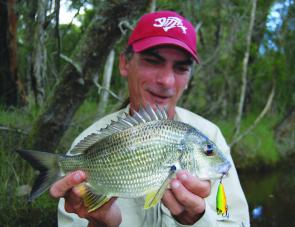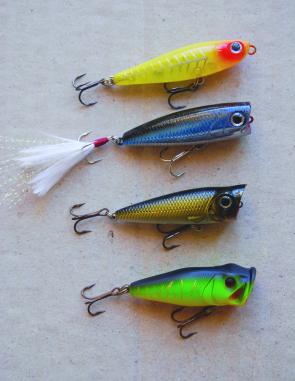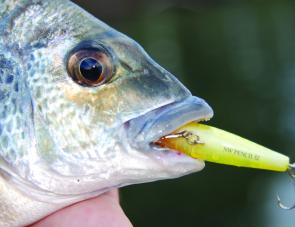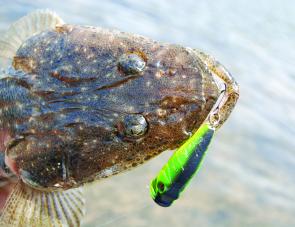Although focused on Central Coast lakes, a lot of these tips will help you have a poppin’ good time elsewhere.
SECTION: feature
MAPS:
Facts
ILLUSTRATIONS: 0
Small poppers and other tiny topwater lures have really taken off over the past year as a fun alternative to soft plastics, crankbaits and other fishy offerings.
Estuary anglers right along the east coast are experimenting more and more to find out exactly what effect these little lures have on their local fish.
So as a helping hand to those who fish around Tuggerah Lakes and the southern parts of Lake Macquarie, here is a guide to catching fish around these vast waterways.
Both systems are unique in that they have relatively small entrances to the sea in comparison to the huge volume of water that makes up the lakes as a whole. So while tidal flow at The Entrance on Tuggerah Lakes and Swansea on Lake Macquarie may be as strong as any other east coast estuary, the majority of both lake systems sees little in the way of current.
There isn't much up-and-down movement in the water levels, either, so some fishing theories that revolve around the tide cycle that affects other estuaries may not be of much use when fishing the lakes.
On the other hand, factors such as barometric pressure and moon phases can have a greater effect on local fish behaviour.
The general make-up of the lakes also means that fish may be quite widespread, penetrating every nook and cranny around the shallow margins of the lakes.
There are no oyster racks here and not a lot in the way of rock walls, mudflats or mangroves – all key fish-attracting structure in the majority of our estuaries.
However, you will find weed beds and weed and some more weed in amongst that. One of my mates once described Tuggerah Lakes as one giant weed bed and he wasn't far from the truth.
Of course, there are other forms of structure around the lakes, like fallen timber up the creeks, quite a few rocky points and artificial stuff like bridges, wharves and pontoons.
We should also consider the local power stations, like Vales Point and Munmorah, which use the lake water to cool the giant turbines. They not only create permanent currents in some parts of the lakes but also warm the water, particularly around San Remo, Wyee Bay and Mannering Park.
All of the above factors have some influence on fish behaviour and should be considered when trying to catch fish on poppers as well as other techniques. We'll get to some more detail on that in a minute, but first let's run through some tackle and techniques.
Regardless of which estuary system small surface lures are to be cast upon, a lightweight flick stick outfit is the way to go. I use a 2.1m Loomis Dropshot rod and Daiwa Sol 2000 spooled with 5kg Castaway braid. This outfit is light in the hand, easy to use and casts small lures with ease.
What you don't want is a rod that's too stiff or heavy in action because it won't be very good for casting small lures. A rod that's too short won't be so effective when it comes to working the lure, either.
Another thing to avoid is thick line that can also inhibit your casting ability.
Although fluorocarbon can be used as leader material for surface lures, we should remember that fluorocarbon sinks, so conventional nylon mono is a better alternative for surface lures.
Most of the successful lure types have been mentioned in the pages of Fishing Monthly quite a bit over recent months. Some of my favourites for the lakes are Lucky Craft Bevy Poppers and NW Pencils, Sure Catch poppers and River 2 Sea poppers.
Some say that colour doesn't really matter but I seem to have had more success with lighter colours like yellow or white on the belly of the lure. I don't think the top colour matters much because the fish aren't really looking from that view anyway.
Retrieve techniques that catch fish may vary considerably. I enjoy playing games with fish, especially when it comes to curious bream.
If you spot a fish that's having a close look from behind, make like the lure is trying to get away. A series of rapid hops verging on an almost straight, fast retrieve for two or three metres quite often results in a very aggressive strike. To me, that's the whole idea of the game – visual entertainment.
In most cases, however, it's best to make a long cast and soon after the lure splashes down, start working it back in short, sharp movements to attract any attention and then pause it for a couple of seconds every few metres.
A lot of bream come up and smash the lure after it's been sitting there motionless for a few minutes. Curiosity just ends up getting the better of them.
Both lake systems have plenty of shoreline where surface lures can be fished successfully for bream and whiting. Generally, though, more fish will be encountered in water no more than a metre deep.
Those extensive weed beds with clear sandy patches or sandy pathways between them are the main areas worth fishing, especially if there is a little bit of other structure like rock or fallen timber nearby.
The following areas are some good starting points. In Tuggerah Lakes The Entrance, North Entrance, the northern end of Lake Munmorah, the extensive weed beds south of Budgewoi and the mouths of Wyong, Ourimbah and Wallarah creeks are all good.
In southern Lake Macquarie; Wyee Bay, Mannering Park, Chain Valley Bay, Crangan Bay near Nords Wharf and Salts Bay at Swansea are prime popping spots.
The dark or new moon phase is the best time to practise this type of fishing. That's when the prawns are most active, which gets bream and whiting all fired up and looking for food on the surface.
The few days around the full moon aren't overly productive but if you do intend to fish at this time, try the afternoon rather than the morning.
Warmer weather, with a light afternoon north-east breeze or a calm morning are also better than just after a southerly change, when surface temperature of the lakes drop a few degrees.
When fishing at Swansea or The Entrance, a rising tide tends to produce better. For the rest of the areas around the lakes, don't worry much about the tides because it doesn't make a huge difference.
Barometric pressure does make a difference, though, with a high or rising barometer putting the lake's fish in a more active mood than a low or falling barometer.
Once armed with the right gear, it's a simple matter of casting over the shallows until success comes your way.
Don't be tempted to swap over to a soft plastic or diving lure, just keep casting and never think any water is too shallow.

The author with another lake bream taken on a popper cast over shallow weed beds early in the morning.

Plenty of shore-based spots exist around the shallow fringes of the Tuggerah lakes. John Grant tries his luck on the southern side of Swansea Channel.

Some of the author's favourite topwater bream lures. From top, Lucky Craft NW Pencil, Lucky Craft Bevy Popper, Sure Catch popper, River 2 Sea 45mm popper.

Bream certainly become aggressive when it comes to splashy little lures on top. This one, taken at Nords Wharf, is just about choking on the NW Pencil.

Bream make up the bulk of the catch around the shallow lake margins.

Flathead won't say no to a surface lure but are more likely to hit such lures in very shallow water.

The shallow, rocky points on the southern side of Toukley bridge are ideal bream habitat, although there are a number of other similar areas around Tuggerah Lakes.

This mix of clean sand and shallow weed beds on the western side of The Entrance bridge is perfect territory for bream, whiting and flathead.




